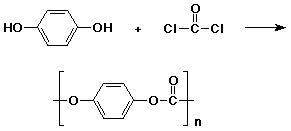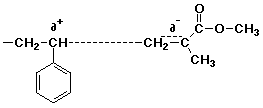Chem 336 - Spring 1999 - Organic Chemistry III
Portland State University - Dr. Carl C. Wamser
Chapter 23 Homework Answers
Brown & Foote, pages 941 - 946 :
Problems 23.5 - 14 , 19 - 22 , 24 - 29 , 31 - 34
1. Draw the polymer expected from reaction of phosgene with hydroquinone. What category of polymer is this?

This would be considered a condensation polymer and a polycarbonate.
2. A mixture of styrene and methyl methacrylate gives different products depending on the type of initiation. With cations, only polystyrene is formed; with anions, only PMMA is formed; with radicals, a 1:1 alternating copolymer is formed. Explain each of these observations. In particular, explain why a 1:1 alternating copolymer is formed with radical initiation.
Cationic polymerization only works well if the intermediate cation is stabilized as in the benzylic cation from polystyrene polymerization.
Similarly, anionic polymerization only works well if the intermediate anion is stabilized as in the enolate anion from poly(methyl methacrylate) polymerization.
Radical polymerization works well in most cases of vinyl polymerizations. However, if the monomers are polar, there will be a tendency for a growing chain with an electron-rich monomer at the growing end to prefer to react with the next monomer that is electron-deficient (and vice versa). Radical transition states can be stabilized by polar effects.
